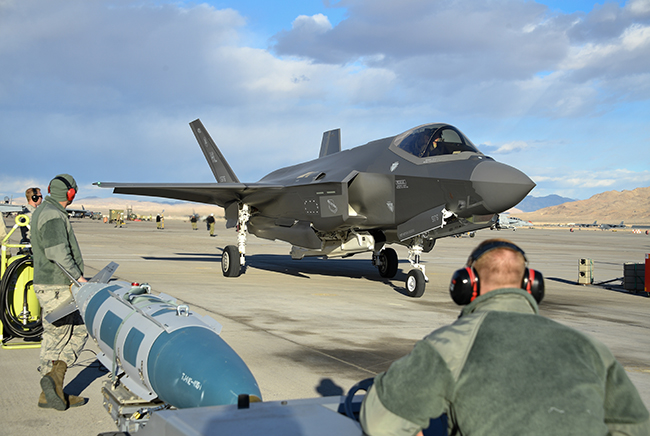
388th Fighter Wing airmen prepare to load an F-35A prior to a sortie during Red Flag 19-1 at Nellis AFB, Nev. Air Force photo by R. Nial Bradshaw.
The F-35 program is driving toward two goals to drop the Air Force variant’s cost per flying hour over the next several years, seeking to hit $34,000 per flying hour by 2024 and $25,000 by 2025, the head of the F-35 Joint Program Office told lawmakers Thursday.
It currently costs $44,000 an hour to operate the Air Force’s F-35A as of fiscal 2018, Navy Vice Adm. Mat Winter said at a House Armed Services tactical air and land forces subcommittee hearing.
“We have targets over the … next five years to understand how we can actually march down the cost per flying hour … to an affordable cost per flying hour for the United States services because they have other demands for those resources outside of F-35,” Winter said.
He acknowledged the latter goal, dubbed “25 by ‘25,” will be very difficult to meet.
“The stretch goal was given to us [by DOD leadership] … because it’s the first year outside the [future years defense plan],” Winter told reporters after the hearing. “On average, we are coming down and we have to come down between 7 and 12 percent a year.”
It’s about a 23 percent drop from $44,000 to $34,000, which would be spread across the next five years, followed by a 26 percent change from $34,000 to $25,000 in the span of one year.
Robert Daigle, who runs the Defense Department’s Cost Analysis and Program Evaluation office, noted that CAPE’s estimate sits slightly higher at $36,000 per F-35A flying hour. While slightly different, Winter said the higher amount is still within an acceptable margin.
But Daigle indicated the loftier goal may be too burdensome.
“The department doesn’t see a path to get to $25,000 per flying hour by FY-25,” Daigle told lawmakers. “There’s a fair number of studies going on right now that are going to provide some more information to that. but that’s a target, and it’s not our projections for where we’re actually going to be.”
After 2024, CAPE expects flying-hour costs will flatten and then rise again as the Lockheed Martin-built fighter jets age and require more depot work.
The Pentagon already knows the “levers” it needs to pull to head in the right direction: initiatives that include getting spare parts faster, depot-level repair for those parts, and enabling flight line maintenance to shrink aircraft turnaround times.
But the JPO won’t do anything differently between now and 2024 — when it wants to lower cost per flying hour by $10,000 over five years — and the $9,000 it looks to chop from 2024 to 2025.
“I’m going to be flying this aircraft to 2077,” Winter told Air Force Magazine. “I’m focused to make sure this is affordable for the long term. What’s important is we won’t know how steep that drop is until we get to 2024.”
There is now a department-wide consensus on how to find the cost per flying hour, which accounts for the Autonomic Logistics Information System and other aspects that aren’t part of other airframe calculations, Winter added.
Following a two-hour hearing in which the debate over whether the Air Force should buy Boeing’s F-15EX in addition to or instead of the F-35 was a key issue, Winter also told reporters he isn’t too concerned about the Air Force’s decision to buy the fourth-generation fighter because the F-35 program is bolstered by international interest.
“I’ve got a ramp overall on that production line that’s still efficient,” he said. “If we were only buying F-35As, this would be very impactful. We have As, Bs, and Cs across 13 customers, and so the ramp is still moving forward.”